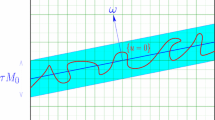Summary
We study in this paper the hysteretic behavior of a discrete system constituted by a finite number of elements (“snap-springs”) whose energy has two parabolic wells. The guideline idea is that, in many circumstances, hysteresis can be due to the presence of relative minimizers of a potential (“metastable states”) in which the system might get locked during its quasistatic evolution. A careful investigation is thus carried out of the relative minimizers of the total energy of our system of snap-springs under imposed total displacement, and of the barriers separating them. This is done both in the case of noninteracting elements and in the case in which some interaction is present that gives rise in the energy to an extra “coherence” term of special form. The results allow discussion of various hysteretic phenomena, also in the presence of vibrational motion of the elements. This study of a simple but suggestive discrete system will hopefully prove itself of help in understanding the implications regarding hysteresis of certain continuum theories recently proposed to model phase transitions in the solid state, in which the energy density is assumed, as here, to be biparabolic, and in which the coherence energy term we adopt arises in a natural way when equilibria involving mixtures of kinematically noncoherent phases are considered. In these cases the optimal microstructures are known to be layered, and physically this gives a good basis to our discrete calculation.
Similar content being viewed by others
References
Müller, I., Villaggio, P.: “A model for an elastic-plastic body,”Arch. Rat. Mech. Anal. 65 (1977), 25–46.
Müller, I.: “A model for a body with shape memory,”Arch. Rat. Mech. Anal. 70 (1979), 61–77.
Croll, J. G. A., Walker, A. C.:Elements of Structural Stability, London: Macmillan, (1972).
Müller, I. Xu, H.: “On the pseudo-elastic hysteresis,”Acta Metall. 39 (1991), 263–271.
Kohn, R.: “The relaxation of a double-well energy,”Cont. Mech. Thermodyn. 3 (1991), 193–236.
Fedelich, B., Zanzotto, G.: “One-dimensional quasistatic nonisothermal evolution of shape memory material inside the hysteresis loop,”Cont. Mech. Thermodyn. 3 (1991), 251–276.
Müller, I.: “On the size of hysteresis in pseudoelasticity,”Cont. Mech. Thermodyn. 1 (1989), 125–142.
Author information
Authors and Affiliations
Additional information
Communicated by Robert Kohn
Rights and permissions
About this article
Cite this article
Fedelich, B., Zanzotto, G. Hysteresis in discrete systems of possibly interacting elements with a double-well energy. J Nonlinear Sci 2, 319–342 (1992). https://doi.org/10.1007/BF01208928
Received:
Accepted:
Issue Date:
DOI: https://doi.org/10.1007/BF01208928




